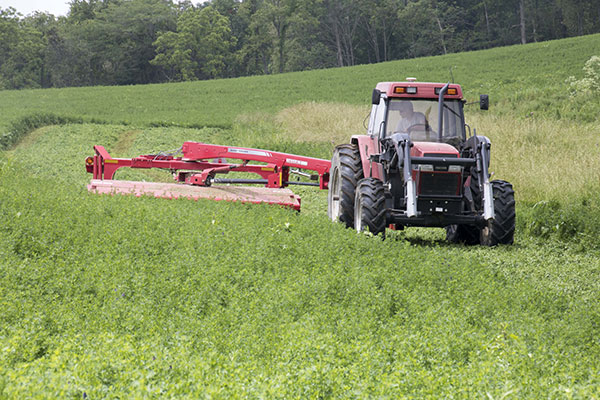
Several helpful and easy tips on making those adjustments that may be unfamiliar or underutilized were recently discussed by Penn State University forage specialists Marvin Hall and Jessica Williamson.
Key components of their presentation were summarized by Joel Hunter, Penn State University field and forage crops educator, and reported in a recent edition of extension’s Field and Forage Crop News.
When disc mowers are set to cut too low, crops experience slow regrowth and often an elevated ash content.
Skid shoe alterations change the cutting head height. Lodged crops require raising the skid shoes to tip the knives forward for a lower cutting height. Conversely, if fields are rocky, lowering skid shoes to raise cutting height is necessary.
Cutting angle of the bar can be adjusted between 4 and 10 degrees below horizontal. Set at a 4 degree angle in rough or rocky conditions, a 7 degree angle in normal conditions, and a 10 degree angle for a downed crop.
The head should float or ride over objects. This is accomplished by using a “milk” spring scale to check the necessary lifting force of each side of the head. The forage specialists recommend a float setting of 35 to 50 pounds for rocky fields and 50 to 70 pounds for normal conditions.
Conditioner
The ultimate goal when cutting hay is achieving adequate conditioning and drying, while minimizing leaf loss. Underconditioning elevates the risk of rain damage, while overconditioning boosts cutting, raking, and baling losses.
For roll conditioners, focus on roll clearance and roll pressure. Some key points to keep in mind for properly adjusting roll conditioners are as follows:
1. Set the conditioner roll clearance at 1/16 inch, which creates noticeable steam breakage and accelerates stem drying. At least 90 percent of stems should be broken or crimped every 3 to 4 inches. Setting roll gap is the most critical adjustment and can be checked with rolls of aluminum foil (12 inches by 12 inches) rolled into 1-inch tubes. Measure the foil thickness after feeding it through the rolls, which can be turned by hand.
2. Roll pressure needs to be set tight enough to achieve a consistent roll gap. Tension may need to be loosened with less mature crops to prevent overconditioning. Watch rolls for excessive wear in the center over time. Replace worn rolls for more uniform and consistent drying.
3. Lay out an even windrow that is as flat and wide as possible, without ridges or clumps of crop. Wide windrows reduce drying time, resulting in better leaf retention. For the widest possible windrow, set the “swath board” at its lowest or flattest position.
Impeller or tine conditioners are designed for grasses rather than alfalfa. Check impeller speed and clearance between the impeller and hood. Slow rotor speed is desirable to eliminate overconditioning. Narrow the hood clearance for adequate conditioning but not so close that leaves are shredded. Reducing clearance too much results in machine plugging.
Closely examine stems before making alterations. If the waxy layer is showing scratches, conditioning is good. Widening the clearance between the rotating finger and hood will lower conditioning intensity.
The harvest process begins with the mower-conditioner. Properly adjusted, it can speed drying time and result in higher quality hay with a lower ash content.

